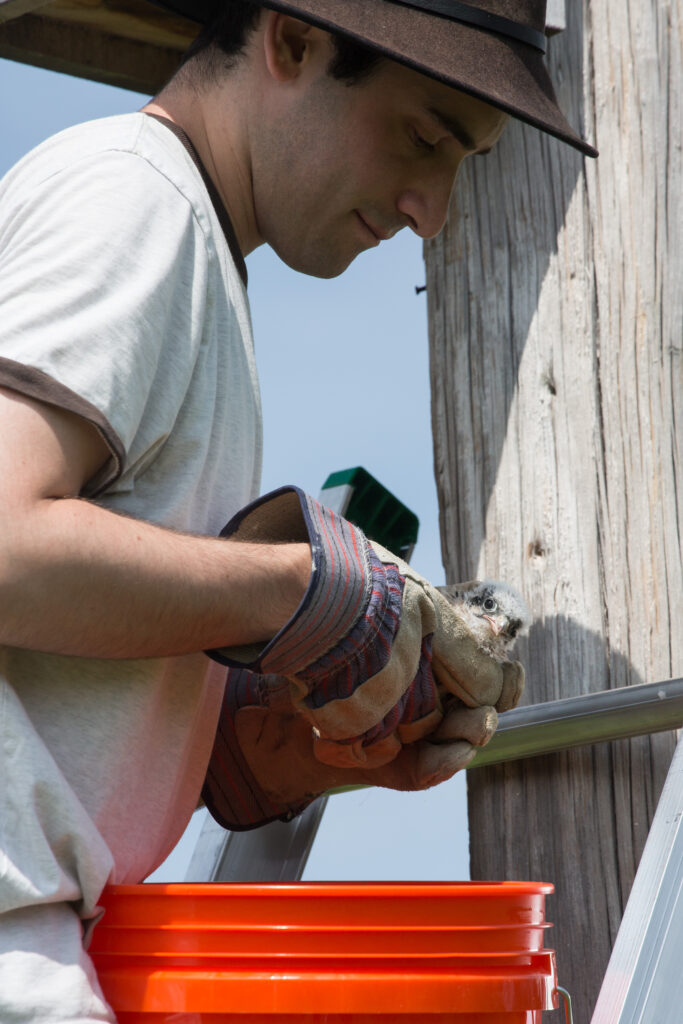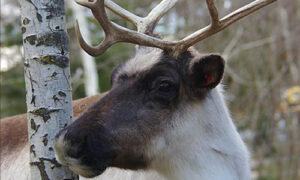This week and next, we’re taking you on a tour of some of our staff’s wildest animal experiences during our long and varied career. We hope you enjoy these stories and come to know our team a little bit better!

“Before I came to Zoo New England, I was a bird researcher. My dissertation was on American kestrels (Falco sparverius), cute and colorful little falcons that nest in tree cavities or in nest boxes put up by humans. I was monitoring a large network of nest boxes all across the state, climbing up a 12-foot ladder and checking them regularly during the breeding season to see which ones had kestrels in them. During these checks, we also found a lot of things that were not kestrels: sparrow and starling nests, squirrel caches, spongy moth infestations, and more. The most memorable nest check, though, was one out in a warm, open field in central Massachusetts. I climbed up my ladder while my undergraduate research assistant stood below on the ground, holding the ladder steady. I opened the side-door of the box and peeked inside, seeing only some old wood chips and no kestrel nest. This wasn’t unusual, so I reached in to clear out the old wood chips and add some new ones from the bag wrapped around my wrist. I was halfway through my second scoop when I noticed that my arm was hurting, so I pulled it out of the box to find it covered in Northern paper wasps (Polistes fuscatus), which had just started stinging me! Their nest, I found out later, had been tucked in the corner above the side door I had opened and was therefore out of my line of sight. I jumped off the 12-foot ladder with my arm covered in angry wasps, swinging my bag of wood chips wildly and screaming “BEES! RUN!” to my terrified undergraduate research assistant.
We ran. Other than six wasp stings on my forearm, I was uninjured, which I attribute mostly to dumb luck and adrenaline.”
– Matthew Kamm, Conservation Outreach Coordinator
“For one summer I worked as a field assistant observing and trapping Gunnison’s prairie dogs (Cynomys gunnisoni) at a national preserve in New Mexico. One of my favorite memories from the position was assisting with behavioral research on the prairie dog colony, conducting ‘fake badger pulls.’ This comically involved one of the field assistants hand-cranking a few hundred feet of rope attached to a stuffed badger that was pulled across the prairie fields. While the badger was being pulled, the other field assistants recorded the prairie dog reactions. Badgers are one of the top predators of prairie dogs and we would observe wild ones occasionally in the colony. However, these behavioral experiments allowed us to systematically record prairie dog behavioral responses to a badger in the colony. Prairie dogs are actually known to have different behavioral responses for different predators, so they know how to react whether it is a hawk that may swoop down from above versus something like a badger or coyote running on the ground. This experience was one of the only true behavioral research experiments I have been able to help with, and it was fascinating to observe the communal response of the colony in order to avoid predators.”
– Jimmy Welch, Field Biologist

“As a former zoo keeper at Zoo New England and the Bronx Zoo I would get asked ‘What is the most dangerous animal you work with?’ I would quickly respond our male reindeer ‘Cornelius’ at Stone Zoo (Cornelius has since passed on). People would have a surprised expression, ‘Reindeer?’ Males in the deer family (reindeer, deer, moose, elk) go into ‘rut’ starting in September and lasting through the fall months, after the soft velvety layer on the antlers falls off. We often see in nature films males sparring (sometimes quite forcefully), locking antlers with each other competing for dominance to breed with the females. Imagine you being the target as though you were a rival male. That’s exactly how Cornelius viewed me and the other keepers. If he saw us during his rut, he would charge the fence (plywood boards were up so he wouldn’t damage the fence). When we were letting him in or out of his barn using a pully system outside his stall, he would vigorously bang on the door with his antlers. His goal was to use the full force and strength of his antlers on us without hesitation, which would cause very serious if not life-threatening injuries if we went in with him. However, all of this behavior was short-lived, less than three months. Usually by the end of November his antlers fell off. Often, he seemed confused for a day or so. Even before antlers drop, hormone levels would drop and his behavior started to mellow. After the antlers were gone it was like Mr. Hyde and Dr. Jekyll – a complete reversal of personality. He became the sweet, calm animal he was known to be the rest of the nine months of year. And yes, we could open the top stall door and give him scratches behind the ears or on the nose and even go in the yard with him to feed him his grain and hay.
True, the large cats, bears and other large zoo animals could be a serious threat. but that’s expected and hence the reason keepers don’t go inside the enclosure with those animals. But reindeer?? Well, at least for those few months…”
– John Berkholtz, Senior Field Conservationist
